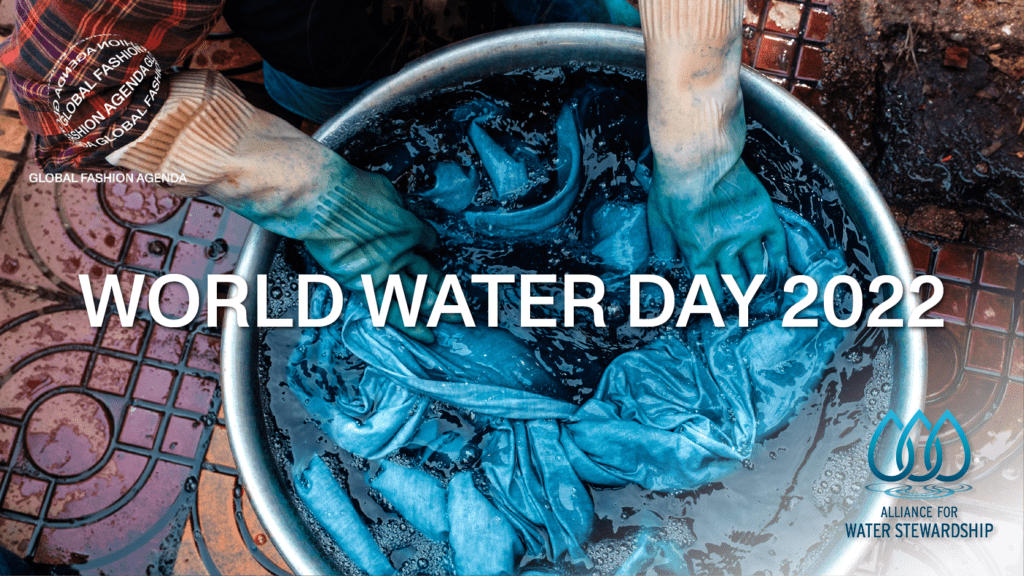World Water Day 2022: Fashion’s Water Consumption and Pollution


World Water Day, held on 22 March every year since 1993, celebrates water and raises awareness of the two billion people living without access to safe water.
An annual United Nations Observance, World Water Day is primarily a day to support the achievement of Sustainable Development Goal 6: water and sanitation for all by 2030.
This 2022, the focus is groundwater, an invisible resource with an impact visible everywhere.
So, what does World Water Day have to do with fashion? The textile industry is heavily reliant on fresh water across the whole value chain – from raw material production through to product use and ultimate disposal and is accountable for approximately four per cent of global freshwater withdrawals. As for our oceans; scientists estimate that textiles produce 35% of the microplastic pollution in the world’s oceans, which would make textiles the largest known source of marine microplastic pollution. These are just some examples of the many ways in which fashion contributes to water consumption and pollution.
Despite various statistics echoed throughout the industry, it is near impossible to accurately sum up fashion’s impact on water – this is not helped by a lack of transparency upstream of the value chain, not only challenging identification of impact but also the necessary actions. Despite lack of comprehensive statistics, fashion’s impact is undeniable – for example, cotton production has been linked to instances such as the dried up South Aral Sea basin.
Currently, most apparel and textile sector water strategies are focused on the direct water impacts of the brands and suppliers in their value chain. But these approaches don’t address all of the water risks the industry faces. Businesses don’t operate in a bubble; they are part of complex societies and reliant on the natural ecosystems that surround them. Since water risks vary from region to region, solutions need to be site-specific.
Multi-stakeholder organisation Alliance for Water Stewardship (AWS) promote a holistic stewarding approach to water use. Water stewardship is a cooperative and multi-stakeholder approach that enables a ‘bigger picture’ perspective by managing a site’s direct water impacts (water management), and then also working with others in the catchment area to address shared water risks and challenges (water stewardship). For example, a dye house in an area experiencing water scarcity may be as efficient and non-polluting as possible, but without working with external stakeholders on both a local (for example, fellow business owners and local agencies) and national level (such as national governments, international NGOs), the site will continue to face water risks.
Whilst water stewardship must happen in places, often these actions are enabled through engagement at the catchment and global level. For this reason AWS formed a global Textiles & Apparel Working Group to ignite and nurture global and local leadership in water stewardship in the sector.
So far, the Textiles and Apparel Working Group has successfully identified key sourcing hubs where members are keen to advance (and, where possible, combine) their water stewardship efforts. This has already initiated a country specific working group in Bangladesh. The group is working to further water stewardship activities through the supply chains of three global textile retailers, in collaboration with local stakeholders from civil society and the public sector.
AWS are seeking to replicate this approach in other key sourcing hubs that are facing significant water risks and that are strategically important for the textiles and apparel sector, such as India, Turkey, and Vietnam. At the core of this approach is the understanding that water stewardship is not about reinventing wheels or creating new approaches, but rather it is about complementing existing efforts.
The International Water Stewardship Standard (AWS Standard) offers a credible, globally applicable framework that allows corporate sustainability strategies to connect on-site actions with an understanding of the local contexts they operate in. It is built on a foundation of collaboration and continual improvement and provides a robust way for water users to work with their stakeholders, both globally and locally in value chain hubs.
By focusing efforts on key hubs identified through the working group, AWS can focus on sharing knowledge and learning with the right stakeholders and build capacity in the right localities for maximum impact.
It is essential that the industry puts water at the heart of a sustainable future and begin tackling the biggest risks to water security for the people and ecosystems in apparel supply chains and beyond.
To contribute to global efforts tackling water security within textile supply chains, apply to join the Textiles & Apparel Working Group here.
The Next Gen Assembly (NGA) 2025 has brought together a diverse group of fashion designers, systems thinkers, social entrepreneurs, and storytellers from across the globe - united by one essential goal: advocating for the rights of nature.